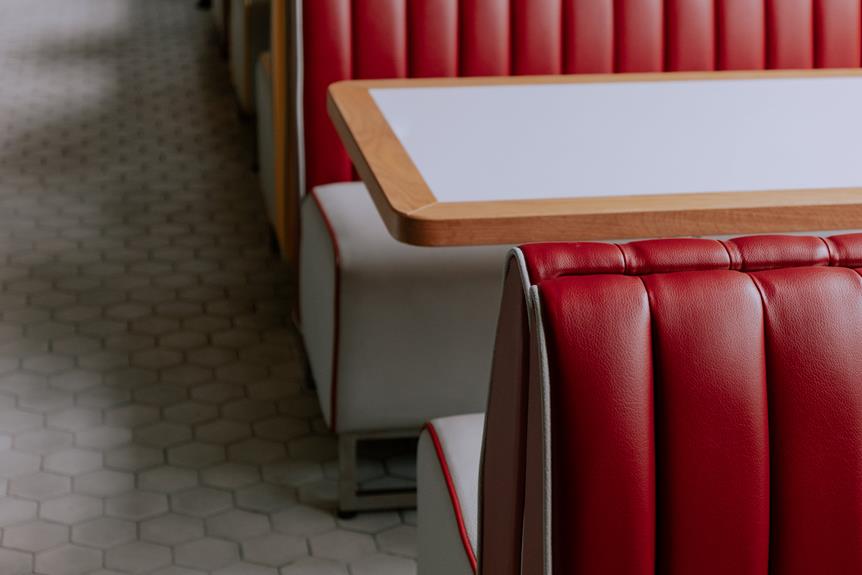Wondering what the best glue is for repairing your leather seats? You're not alone. With so many options out there, it can be challenging to determine which one will provide the strongest and most durable bond.
But fear not, because we're here to help you navigate the world of leather seat repair glues. In this guide, we'll explore the different types of glues available, factors to consider when choosing the right one, and top-rated options that have garnered praise from experts and enthusiasts alike.
So, if you're ready to learn about the best glue for repairing leather seats, let's dive in and find the perfect solution for your needs.
Key Takeaways
- Water-based and solvent-based glues are the two main types of glue used for repairing leather seats.
- When choosing glue for leather seat repair, factors such as adhesive strength, flexibility, compatibility with leather, drying time, and color should be considered.
- Glue specifically designed for leather repair is beneficial as it provides strong adhesive strength and flexibility to accommodate leather movement.
- Compatibility with leather, including color matching and water resistance, is important for achieving a durable and long-lasting repair.
Types of Leather Seat Repair Glues
When repairing leather seats, you should consider different types of glues for the best results. There are various types of glues suitable for leather seat repair, each with its own application methods, pros, and cons.
The two most common types of glue for repairing leather seats are water-based and solvent-based adhesives. Water-based glues are easy to clean up and offer a more environmentally friendly option. However, they may not be as durable as solvent-based glues, especially in high-heat environments. On the other hand, solvent-based glues provide a stronger bond and are more resistant to heat and moisture, making them ideal for long-lasting repairs.
Before applying any type of glue, it's crucial to prepare the leather properly. Thoroughly clean the area to be repaired using a mild leather cleaner and allow it to dry completely before applying the adhesive. Proper leather preparation and cleaning techniques are essential to ensure that the glue adheres effectively and the repair is long-lasting.
Understanding the differences between these types of glues and the appropriate leather preparation methods will help you make an informed decision when repairing leather seats.
Factors to Consider When Choosing Glue
When choosing a glue for repairing leather seats, there are several key factors to consider.
First, you'll want to look at the adhesive strength and flexibility of the glue to ensure a lasting and durable repair.
Additionally, it's important to choose a glue that's compatible with leather and dries in a reasonable amount of time.
You'll also want to select a glue that blends in well with the color of the leather.
Adhesive Strength and Flexibility
You need a glue that provides strong adhesive strength and flexibility when repairing leather seats. Adhesive bonding is crucial for leather restoration, so choose a glue that forms a durable and long-lasting bond. Look for a product that offers superior adhesion to leather and can withstand the stress and movement that leather seats experience.
Flexibility is equally important as leather is prone to stretching and bending. The glue should be able to flex with the leather without losing its bonding properties. Consider a glue specifically designed for leather repair, as these are formulated to provide the necessary strength and flexibility for successful repairs.
Compatibility With Leather
To ensure compatibility with leather, it's essential to consider the specific properties of the glue when choosing a product for repairing leather seats. When selecting a glue for leather repair, you should consider the following factors to ensure optimal leather adhesion and material compatibility:
- Flexibility: Look for a glue that provides flexibility once it sets, allowing the leather to move and bend without causing the glue to crack or weaken.
- Color: Opt for a glue that dries to a color that closely matches the leather to ensure seamless blending and a professional finish.
- Water Resistance: Choose a glue that offers resistance to water and moisture to prevent damage and deterioration over time.
Considering these factors will help you select a glue that's compatible with leather, ensuring a durable and long-lasting repair.
Drying Time and Color
Consider the drying time and color of the glue when choosing the best adhesive for repairing leather seats. Opt for a glue with a quick drying time, as it will allow you to efficiently complete the repair without extended waiting periods.
Additionally, consider the color matching aspect to ensure that the glue seamlessly blends with the color of the leather seats. Some glues are specifically designed to dry in a color that closely resembles leather, making them ideal for achieving a discreet and professional finish.
When applying the glue, ensure that it's spread evenly and covers the entire area needing repair. This will help to maintain the structural integrity of the leather and provide a lasting fix.
Top-Rated Leather Seat Repair Glues
When repairing leather seats, it's important to look for a glue that offers strong adhesion to ensure a lasting fix. Additionally, a quick drying time can help you complete the repair efficiently.
These are key points to consider when evaluating the top-rated leather seat repair glues on the market.
Strong Adhesion for Leather
You should choose a top-rated leather seat repair glue with strong adhesion for effective repair. When looking for a leather seat repair glue, consider the following top-rated options for their strong adhesion:
- Gorilla Super Glue Gel: Known for its strong bond and quick-drying formula, making it ideal for leather seat repairs.
- Tear Mender Instant Fabric and Leather Adhesive: This adhesive offers a flexible and durable bond, perfect for repairing leather seats.
- 3M Leather and Vinyl Repair Kit: This comprehensive kit includes a strong adhesive that seamlessly bonds with leather, ensuring a reliable and long-lasting repair.
Opting for a leather seat repair glue with strong adhesion is crucial for ensuring that the repair is durable and long-lasting, providing a professional finish to your DIY repairs.
Quick Drying Time
To ensure efficient leather seat repairs, opt for top-rated glues with quick-drying formulas, such as Gorilla Super Glue Gel, Tear Mender Instant Fabric and Leather Adhesive, and the 3M Leather and Vinyl Repair Kit.
These glues are designed to dry rapidly, allowing you to complete your repairs swiftly and effectively. Gorilla Super Glue Gel, for instance, dries in just 10-45 seconds, providing a quick solution for your leather seat repair needs.
Furthermore, the Tear Mender Instant Fabric and Leather Adhesive boasts a rapid drying time of 1-2 minutes, ensuring that your repairs are completed in no time.
Not only do these glues dry quickly, but they also offer excellent heat resistance, ensuring that your leather seats remain in top condition even under high temperatures.
Application Techniques and Tips
For achieving the best results when applying glue to repair leather seats, it's important to evenly spread the adhesive using a small spatula or brush. Proper application techniques are crucial for a successful leather seat repair. Here are some tips to help you achieve the best results:
- Leather Preparation: Before applying the glue, ensure that the leather surface is clean and free from any dust, dirt, or oils. Use a leather cleaner and a soft cloth to gently clean the area that needs repair. This will help the glue adhere better to the leather, ensuring a stronger bond.
- Even Application: When spreading the glue, make sure to apply it evenly across the entire area that needs repair. Use a small spatula or brush to spread the adhesive in a thin, uniform layer. This will help prevent any lumps or uneven patches in the repaired area.
- Pressure and Drying: After applying the glue, apply pressure to the repaired area using a clamp or by pressing down firmly. Allow the glue to dry completely according to the manufacturer's instructions before using the repaired leather seat.
Following these application techniques and tips will help you achieve a professional and long-lasting repair for your leather seats.
Long-Term Durability and Maintenance
After allowing the glue to dry completely according to the manufacturer's instructions, regularly condition the repaired leather seat to maintain its long-term durability and appearance. Once the repaired area is fully set, it's important to implement a maintenance schedule to ensure the longevity of the repair.
This involves using a high-quality leather conditioner to keep the leather supple and prevent it from drying out or cracking. Additionally, it's advisable to conduct durability testing on the repaired area periodically to assess its strength and resilience.
To maintain the repaired leather seat, establish a routine for conditioning and cleaning. Consider conditioning the leather at least every six months, or more frequently if the seat is subject to heavy use or exposure to sunlight. Regularly cleaning the leather with a gentle leather cleaner can also help to preserve its condition.
User Reviews and Recommendations
Once the repaired leather seat has been properly conditioned and maintained, you can gather user reviews and recommendations on the best glue for repairing leather seats from online forums and product review websites. User experiences can provide valuable insights into the effectiveness of different glue brands for leather seat repairs.
Here are some factors to consider when comparing user reviews:
- Adhesion Strength: Look for feedback on how well the glue holds the leather together over time and under different conditions.
- Ease of Application: User experiences can shed light on how easy or challenging it's to apply the glue for a seamless repair.
- Long-Term Durability: Consider user feedback on the longevity of the repair and whether the glue maintains its integrity over the years.
When reading user reviews, pay attention to comments that compare different brands of leather seat repair glues. This can help you make an informed decision based on real-world experiences and recommendations.
Frequently Asked Questions
Can Leather Seat Repair Glues Be Used on Other Materials Besides Leather, Such as Vinyl or Fabric?
You can use leather seat repair glues on other materials like vinyl or fabric, but it's essential to consider the specific adhesive's compatibility with different materials. Always follow the manufacturer's guidelines for the best results.
Are There Any Specific Safety Precautions or Health Concerns to Be Aware of When Using Leather Seat Repair Glues?
When using leather seat repair glues, be mindful of safety precautions and health concerns. Ensure proper ventilation, avoid skin contact, and be aware of material compatibility, bonding time, application techniques, maintenance tips, and durability for effective repair.
How Long Does It Typically Take for Leather Seat Repair Glues to Fully Cure and Bond the Leather Back Together?
It typically takes leather seat repair glues 24-48 hours to fully cure and bond the leather back together. The bonding process ensures a strong, durable repair. Be sure to follow the manufacturer's instructions for best results.
Can Leather Seat Repair Glues Be Used to Repair Large Tears or Extensive Damage, or Are They Only Suitable for Small Repairs?
When repairing large tears or extensive damage on leather seats, leather seat repair glues are suitable for small repairs. However, for significant damage or repairs involving other materials like vinyl or fabric, special techniques and products are recommended for durability maintenance. Always follow safety precautions and consider curing time and bonding for optimal results.
Are There Any Special Techniques or Products Recommended for Maintaining the Durability of the Repaired Leather Seats Over Time?
To maintain durability and care for your repaired leather seats over time, consider using a leather conditioner to keep the material supple and protected. Regularly cleaning and moisturizing the seats will help preserve their quality and appearance.
- Tetron Silk Fabric: A Comprehensive Guide - June 17, 2025
- Tetron Rayon Fabric: Features and Applications - June 17, 2025
- Tetron Cotton Fabric: Uses and Benefits - June 17, 2025






